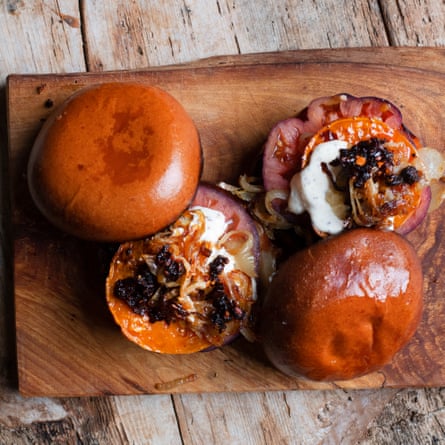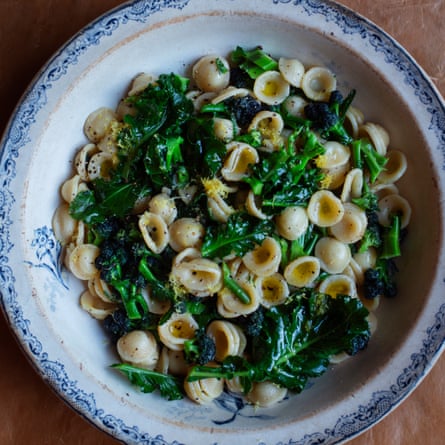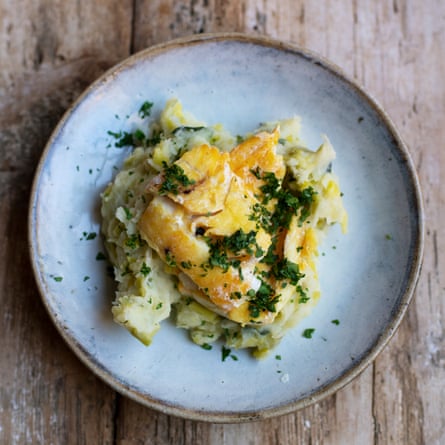There are certain recipes to which I turn each winter – recipes that somehow feel right only when the weather is cold and cupboard supplies are low. The smoky notes of poached haddock and a creamy leek mash; soft buns stuffed with grilled squash and spiced-up creme fraiche, and a soupy dish of pearl barley and dried mushrooms are just three that spring to mind.
A simple midweek roast has become something of a winter staple in this house. Not the full bells and whistles Sunday lunch but something I can do in less than an hour on a Wednesday evening. I pop a few chicken thighs in the oven, then make a side dish of bread sauce, seasoned with thyme leaves and the delicious crusty bits from the roasting tin. Cheap and quick, but it feels almost as special as the Sunday roast.
Another regular visitor to my kitchen at this time of year is a straightforward pasta and greens recipe. I like to use one of the hollow pastas that hold olive oil and grated parmesan, and any greens that look particularly fresh and crisp. This is a great time for greens and I tend to go with whichever look best in the shop, cavolo nero and purple sprouting broccoli being two of my favourites. A simple dish, with barely a handful of ingredients, but one of which I never tire.
The jars of dried ingredients in the cupboard have an important role to play right now. One recipe that I have repeated all winter has been a risotto-style dish of pearl barley and mushrooms. The grain is cooked separately, as it needs a rolling boil. It is at its best left until it is tender but still slightly chewy. I use several types of mushrooms, usually bought in mixed boxes, but there is no reason why you couldn’t make it with chestnut mushrooms alone. The dish, with its deep umami notes, is always a calming presence after a busy day.
The kitchen takes on an especially nurturing role at this time of year. Our daily cooking becomes as much about keeping people warm as it does about having a good time around the table. Shopping expeditions may be less than exciting right now, even something of a challenge, but we can still come up with something good for everyone.
Roast chicken with thyme and bread sauce (pictured above)
Bread sauce polarises opinion, but it is one of my favourite accompaniments for a roast chicken or game bird. I make it in the roasting tin after the chicken has come out, stirring in the deliciousness left behind by the roasted bird, together with chopped thyme and a little butter. My feeling is that it should be served piping hot or not at all, like porridge. A good sourdough produces a thicker, more flavoursome sauce than a plain white loaf.
Serves 2
onion 1, medium
olive oil 2 tbsp
butter 50g
thyme leaves 2 tsp, chopped
chicken thighs 4
For the sauce
milk 300ml
double cream 100ml
fresh white breadcrumbs 150g
thyme leaves 2 tsp, chopped
sage leaves 2 tsp, chopped
Preheat the oven to 200C fan/gas mark 6. Peel the onion and cut in half, then cut each half into four segments. Put the olive oil and butter in a roasting tin and warm briefly on the hob till the butter has melted. Add the thyme leaves, some salt and black pepper and the chicken thighs, skin-side down. Turn them over in the thyme butter so they are nicely coated on both sides, then transfer to the oven and bake for about 35 minutes till golden.
Warm the milk in a saucepan and set aside. When the chicken is ready, remove it and keep it warm, leaving the roasted onion in place. Put the tin over a moderate flame and pour in the milk, scraping at the bottom of the roasting tin to dissolve any sticky residue from the roasted chicken into the milk. Pour in the cream and stir in the breadcrumbs, the thyme and sage and bring to the boil, stirring all the time. Taste for seasoning then serve with the chicken.
Butternut brioche buns

Butternut squash is the cut-and-come-again vegetable. Unless I am due to use it all at once for roasting or soup, I just take off a few slices as I need them and return it to the fridge.
Makes 2 buns
onions 2 medium
olive oil 2 tbsp, plus a little extra
butternut squash 8 thin slices
creme fraiche 6 tbsp
grain mustard 1-2 tbsp
brioche buns or baps 2
tomato 1
Lao Gan Ma crispy chilli oil 2 tsp
Peel the onions and slice them thinly into rounds. Warm the olive oil in a shallow pan, stir in the onions and leave them to cook over a moderate heat for about 15 minutes until soft and deep golden in colour. Set them aside.
While the onions are cooking, peel and thinly slice a chunk of butternut into rounds about the thickness of a £2 coin. Place them in a single layer on a grill pan or baking sheet, brush on both sides with a little olive oil and season with salt and black pepper. Heat an overhead grill and cook the butternut slices for about 10 minutes till golden, then turn and cook the other side. Make sure they are soft and tender.
Mix together the creme fraiche and mustard. Split the brioche buns in half and toast the cut surfaces until golden. Slice the tomato. Divide the onions between the buns, place slices of tomato and butternut on top of the onions followed by a spoonful of the mustard creme fraiche and a little of the Lao Gan Ma. Place the second piece of brioche on top.
Orecchiette with purple sprouting broccoli

The deep hollows of the orecchiette hold tiny pools of olive oil, lemon zest and grated parmesan in this, the simplest of winter suppers. Purple sprouting is good here, but shredded cavolo nero, savoy cabbage or chopped broccoli are fine too. I often chop a couple of anchovy fillets – finely, almost to a paste – and stir them into the olive oil with the garlic.
Serves 2
purple sprouting broccoli 250g
orecchiette 200g
garlic 2 plump cloves
olive oil 2 tbsp
lemon 1, finely zested and juiced
Bring a large pan of water to the boil and salt it generously. Trim the tough ends of the purple sprouting then cut into small pieces, each about 10-15g in weight. Have a bowl of iced water to hand.
Put a deep pan of water on to boil and, when boiling, dunk the purple sprouting in. Leave for 2 minutes, then lift it out with a draining spoon and transfer to the iced water.
When the water comes back to the boil, tip in the pasta and cook for about 9 minutes. Keep testing until it’s done to your liking. While it is cooking, peel the garlic, then crush to a paste with a good pinch of salt – I find a pestle and mortar easiest.
In a wide saute or frying pan, warm the oil and garlic paste. You don’t want the garlic to colour, so stir as it warms. Roughly chop the cooked purple sprouting and add to the garlic.
Drain the pasta and tip into the oil and sprouting, turning the ingredients over in the pan with a large spoon.
Season the pasta with a little black pepper, then stir in the lemon zest and, if you wish, a little of the juice, then divide between two plates.
Smoked haddock, leek mash

A perennial winter dinner in this house. I vary the mash, sometimes putting spring onions or parsley in, other times making it with waxy potatoes and olive oil for a silkier, sticky mash. A couple of spoonfuls of the smoke-scented milk in which you have poached the fish is quite pleasing trickled over the potatoes.
Serves 2
potatoes 750g, large
leeks 450g
butter 75g, plus a little more
smoked haddock 450g
milk 500ml
bay leaves 3
peppercorns 6
chopped parsley to finish
Peel the potatoes, cut them into large pieces and boil them in deep, salted water till tender.
While the potatoes are cooking, roughly chop and thoroughly wash the leeks. Warm the butter in a saucepan, add the leeks, then cover with a piece of baking parchment and a lid (this discourages browning). Let them cook, with the occasional stir, for about 15-20 minutes until soft.
Drain the potatoes thoroughly then mash them with the softened leeks and keep warm.
Place the haddock fillets in a shallow pan, cover with the milk and 100ml water and add the extra knob of butter. Add the bay leaves and peppercorns and bring to the boil. Lower the heat, cover with a lid and let the fish cook for about 12 minutes. Lift the fish out and drain briefly on kitchen paper.
Place spoonfuls of mash on warm plates, then put a piece of fish on top and spoon over the buttery milk. Finish with the parsley.
Pearl barley, mushrooms, thyme

A dish of peace and calm. Just a hint of warmth from the dried chillies, deeply satisfying and made from mostly store-cupboard staples. I often use the cheaper broken dried mushrooms as an alternative to the more expensive dried porcini. That said, you only need 10g to impart a deep mushroom flavour to the stock. Pearl barley can take anything from 25-40 minutes to cook to tenderness. It is worth testing every few minutes, the ideal texture being both soft and satisfyingly chewy.
Serves 4
dried porcini 10g
pearl barley 250g
onion 1, medium
olive oil 4 tbsp
garlic 2 cloves
thyme leaves 1 tsp
assorted fresh mushrooms 250g
tomato puree 1 tbsp
plain flour 1 tbsp
dried chilli flakes ½ tsp
Put the kettle on. Tip the dried porcini into a heatproof bowl then, when the water is boiling, cover them with 500ml of boiled water and set aside.
In a medium-sized saucepan, cover the pearl barley with twice its volume of water, lightly salt it, then bring to the boil. Lower the heat and let it cook for 30-35 minutes until it is tender and pleasingly chewy.
Peel and roughly chop the onion. Warm the olive oil in a large pan, stir in the onion and let it cook over a moderate heat until pale gold in colour – a good 15-20 minutes. Peel and reduce the garlic to a paste, either by grating on a fine-toothed grater or mashing it with a pestle and mortar. Stir into the onion and continue cooking for a couple of minutes. Chop and add the thyme leaves.
Finely slice any large mushrooms (king oyster, large flat or chestnut). Trim any smaller, fragile varieties (enoki, shimeji). Stir them into the onions and continue cooking for about 5 minutes until they start to colour. Stir in the tomato puree. Leave on the heat for 2-3 minutes, then introduce the flour. Add the dried mushrooms and their soaking water and bring to the boil.
When the liquid boils, lower the heat, season with salt and pepper and stir in the chilli flakes. Simmer for 10 minutes then add the cooked pearl barley. Cook for a further 10-15 minutes, until the mushrooms are soft and silky and the sauce has thickened a little.
Serve in shallow bowls.
The Observer aims to publish recipes for sustainable fish. Check ratings in your region: UK; Australia; US

.png) 3 months ago
75
3 months ago
75

















































